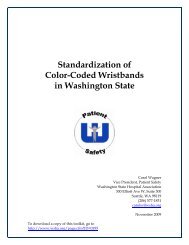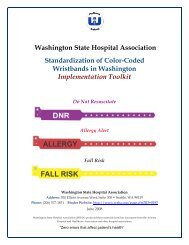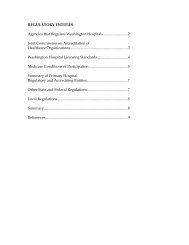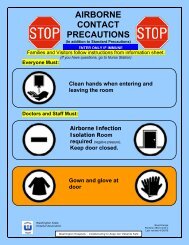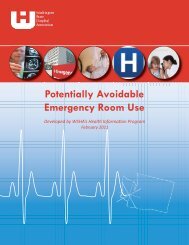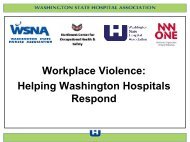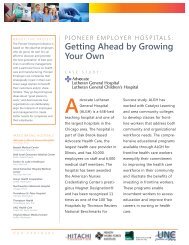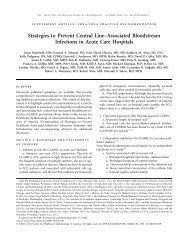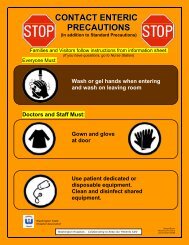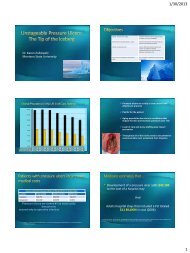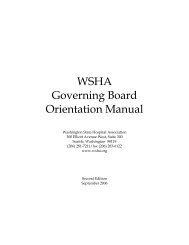Safe Table Webcast - Reducing CAUTI - Washington State Hospital ...
Safe Table Webcast - Reducing CAUTI - Washington State Hospital ...
Safe Table Webcast - Reducing CAUTI - Washington State Hospital ...
You also want an ePaper? Increase the reach of your titles
YUMPU automatically turns print PDFs into web optimized ePapers that Google loves.
<strong>Washington</strong> <strong>State</strong> <strong>Hospital</strong> AssociationPartnership for Patients<strong>Safe</strong> <strong>Table</strong> Web ConferenceHealthcare-AssociatedInfections: <strong>CAUTI</strong>April 11, 2013
<strong>Washington</strong> <strong>State</strong> <strong>Hospital</strong> Association PresenterAmber TheelDirector, Patient <strong>Safe</strong>tyPresented at <strong>Washington</strong> <strong>State</strong> <strong>Hospital</strong> Association <strong>Safe</strong> <strong>Table</strong> Web Conference, April 11, 2013
10 Targeted StrategiesInfection Reduction:• Catheter-associated urinary tract infections (<strong>CAUTI</strong>)• Central line-associated blood stream infections (CLABSI)• Surgical site infections (SSI)• Ventilator-associated pneumonia (VAP)Nursing Care:• Injuries from falls and immobility• Pressure ulcersHigh Risk:• Adverse drug events• Obstetrical adverse events• Venous thromboembolism (VTE)Care Continuum:• Prevention of readmissionsPresented at <strong>Washington</strong> <strong>State</strong> <strong>Hospital</strong> Association <strong>Safe</strong> <strong>Table</strong> Web Conference, April 11, 2013
Presented at <strong>Washington</strong> <strong>State</strong> <strong>Hospital</strong> Association <strong>Safe</strong> <strong>Table</strong> Web Conference, April 11, 2013
Julie McAllister, RN, MN, CVRN, FACCNDirector, ICU & PCUCentral <strong>Washington</strong> <strong>Hospital</strong>Jackie, Whited, RN, BSNClinical Manager, Intensive Care UnitCentral <strong>Washington</strong> <strong>Hospital</strong>
Central <strong>Washington</strong> <strong>Hospital</strong>North Central <strong>Washington</strong>’sRegional Medical CenterPresented at <strong>Washington</strong> <strong>State</strong> <strong>Hospital</strong> Association <strong>Safe</strong> <strong>Table</strong> Web Conference, April 11, 2013
North Central <strong>Washington</strong>Regional ServiceAreaPresented at <strong>Washington</strong> <strong>State</strong> <strong>Hospital</strong> Association <strong>Safe</strong> <strong>Table</strong> Web Conference, April 11, 2013
Statistics• 1350 + Employees Over 440 Bedside RNs• 26,513 ER visits• 1,276 Births• 40,711 Admissions• 3.56 Acute IP LOS• 1.65 Case Mix Index• 6,854 Surgical Cases• 40,936 Physician Services Visits* 2012 Data• 1,042Active/ActiveProvisional/Referring Medical Staff(214 other)Presented at <strong>Washington</strong> <strong>State</strong> <strong>Hospital</strong> Association <strong>Safe</strong> <strong>Table</strong> Web Conference, April 11, 2013
ICU• 20 beds• All Ages: med/surg, CV surgery,occasional pediatric patient• Approximately 3,800 patient days/yearPresented at <strong>Washington</strong> <strong>State</strong> <strong>Hospital</strong> Association <strong>Safe</strong> <strong>Table</strong> Web Conference, April 11, 2013
Foley Days• Average percentage Foley device days– 2011 65-75%– 2012 75%– 2013 76%Presented at <strong>Washington</strong> <strong>State</strong> <strong>Hospital</strong> Association <strong>Safe</strong> <strong>Table</strong> Web Conference, April 11, 2013
Qualis Action Network SummaryPresented at <strong>Washington</strong> <strong>State</strong> <strong>Hospital</strong> Association <strong>Safe</strong> <strong>Table</strong> Web Conference, April 11, 2013
Actual <strong>CAUTI</strong>• 2011 4• 2012 2– (Jan & Oct – Oct questionable, no new sx probably asympbacteriuria, MD called <strong>CAUTI</strong>)• 2013 YTD 0Presented at <strong>Washington</strong> <strong>State</strong> <strong>Hospital</strong> Association <strong>Safe</strong> <strong>Table</strong> Web Conference, April 11, 2013
Education:Keys to Success• Nursing - Identified and empowered a frontline staff RNwith a “Passion for Pee” to research and share bestpractices with her peers. She created a power point, shepresented it at staff meetings, and talked to staff one-onone.• <strong>Hospital</strong>ists – were provided education at their monthlymeeting about <strong>CAUTI</strong> prevention and detection by one ofthe providers.Presented at <strong>Washington</strong> <strong>State</strong> <strong>Hospital</strong> Association <strong>Safe</strong> <strong>Table</strong> Web Conference, April 11, 2013
Product Review:Keys to Success• Stat Lock securement device trial: Staff liked the trialdevice – we chose a different device, but with education,staff are more compliant with utilizing a device.• Reviewed kits that had “prevention guidelines” includedbut decided not to change products.• Found that the OR was routinely breaking the seal to placea urometer on the Thermistor Foley for our open hearts.They purchased a kit that had the correct Foley alreadyconnected to a urometer.Presented at <strong>Washington</strong> <strong>State</strong> <strong>Hospital</strong> Association <strong>Safe</strong> <strong>Table</strong> Web Conference, April 11, 2013
Keys to SuccessContinued reminders used:• Used a poster reminder of appropriate reasons for aFoley in the clean supply room next to thesupplies.• Continued need for Foley is addressedin multidisciplinary rounds as aformal item.• Continued to remind staff at staff meetings of ourcurrent results and to get Foleys out as soon aspossiblePresented at <strong>Washington</strong> <strong>State</strong> <strong>Hospital</strong> Association <strong>Safe</strong> <strong>Table</strong> Web Conference, April 11, 2013
Roadblocks Encountered• Data Collection – our device days are allcollected by hand – feasible in ICU, not on thegeneral units.• Perception that it is easier for nursing andbetter for patients if there is a Foley in place.Presented at <strong>Washington</strong> <strong>State</strong> <strong>Hospital</strong> Association <strong>Safe</strong> <strong>Table</strong> Web Conference, April 11, 2013
EMR RN DocumentationPresented at <strong>Washington</strong> <strong>State</strong> <strong>Hospital</strong> Association <strong>Safe</strong> <strong>Table</strong> Web Conference, April 11, 2013
EMR – MD Order EntryPresented at <strong>Washington</strong> <strong>State</strong> <strong>Hospital</strong> Association <strong>Safe</strong> <strong>Table</strong> Web Conference, April 11, 2013
Questions?Presented at <strong>Washington</strong> <strong>State</strong> <strong>Hospital</strong> Association <strong>Safe</strong> <strong>Table</strong> Web Conference, April 11, 2013
St. Clare <strong>Hospital</strong> Partnering toPrevent <strong>CAUTI</strong>Presented at <strong>Washington</strong> <strong>State</strong> <strong>Hospital</strong> Association <strong>Safe</strong> <strong>Table</strong> Web Conference, April 11, 2013
St. Clare <strong>Hospital</strong>• Part of the Franciscan Health System• Part of Catholic Health Initiatives, a nonprofit healthcaresystem• 106 bed community hospital located in Lakewoodserving South Puget Sound communities• Services provided: Adult acute care patients in ICU,PCU, Ortho/Surgical and Medical Telemetry• 24 hour Emergency Services for all ages• Older building under remodelPresented at <strong>Washington</strong> <strong>State</strong> <strong>Hospital</strong> Association <strong>Safe</strong> <strong>Table</strong> Web Conference, April 11, 2013
PresentersPictured from Right to Left• Laura Staubitz RN MA CIC Infection Prevention St. Clare <strong>Hospital</strong>• Julie Ley RN CCRN ICU Educator St. Clare <strong>Hospital</strong>• Patty Spencer RN BSN BC, ONC Medical Surgical Educator St.Clare <strong>Hospital</strong>• Daidre West RN BSN Risk Manager St. Clare <strong>Hospital</strong>• Marion Ray RN CIC Director of Infection Prevention FranciscanHealth Systems (not pictured)Presented at <strong>Washington</strong> <strong>State</strong> <strong>Hospital</strong> Association <strong>Safe</strong> <strong>Table</strong> Web Conference, April 11, 2013
CHI EBP <strong>CAUTI</strong> Reduction Project• Championed by Risk and Clinical Effectiveness.• Work Group composed of Nurse Managers,Educators, Infection Prevention and ClinicalStaff to improve <strong>CAUTI</strong> rates.• 9 month duration of project using PDCA process(plan, do, check, adjust).• EBP workgroup provided tracking andaccountability.Presented at <strong>Washington</strong> <strong>State</strong> <strong>Hospital</strong> Association <strong>Safe</strong> <strong>Table</strong> Web Conference, April 11, 2013
2009 Creation of <strong>CAUTI</strong> EBP Bundle1. Avoid unnecessary catheteruse.2. Use proper technique.3. Review daily and removepromptly.4. Engage patients and families5. Participate in system widereporting.Presented at <strong>Washington</strong> <strong>State</strong> <strong>Hospital</strong> Association <strong>Safe</strong> <strong>Table</strong> Web Conference, April 11, 2013
New SCIP Quality MeasureStarted with October 2009 discharges• Urinary catheter removed on postop day 1OR• Postop day 2 with day of surgery being day zero– Excluded:• Patients who had a urological, gynecological orperineal operation performed.• Explicit physician documentation of a reason to notremove on postop day 1 or postop day.Presented at <strong>Washington</strong> <strong>State</strong> <strong>Hospital</strong> Association <strong>Safe</strong> <strong>Table</strong> Web Conference, April 11, 2013
2009 CHI Directive to Reduce <strong>CAUTI</strong>Actions taken:•UAR orders– Obtain UAR at the time of catheter insertion– Repeat UAR prior at 48 hours post insertion– Standardized order sets•Urinary Catheter Protocol #967.00•Catheter daily needs assessment and documentation•Clinician education and competency verification•Patients/families receive educationPresented at <strong>Washington</strong> <strong>State</strong> <strong>Hospital</strong> Association <strong>Safe</strong> <strong>Table</strong> Web Conference, April 11, 2013
Identification of UTI’s within 48 Hours• Quality VP directive to assist MD withdetermining colonization vs. true infection– UAR - Urinalysis with Culture if Indicated uponcatheter insertion for baseline– Additional UAR obtained at 48 hours(detect occult urinary tract infection?)Presented at <strong>Washington</strong> <strong>State</strong> <strong>Hospital</strong> Association <strong>Safe</strong> <strong>Table</strong> Web Conference, April 11, 2013
Urinary Catheter Protocol (967.00)Developed & ApprovedThe <strong>CAUTI</strong> Formis to be used forall patients with aretention catheter,not only SCIP core measurepost-op patientsEvaluateevery patient,everyday,for criteriato remove orindications to continuea urinary retention catheterIf the patient has a Foley,use a <strong>CAUTI</strong> FormPresented at <strong>Washington</strong> <strong>State</strong> <strong>Hospital</strong> Association <strong>Safe</strong> <strong>Table</strong> Web Conference, April 11, 2013
Original Urinary Retention Catheter Needs Assessment1. Assessment of needfor retention catheteron daily basiscompleted by RN2. Documentation ofclinical indication tocontinue catheter3. Surgeon signature onPOD1 and POD2 ifclinical indication tocontinue RC4. If none of the clinicalindications apply, theprovider will becontacted to obtainD/C orderPresented at <strong>Washington</strong> <strong>State</strong> <strong>Hospital</strong> Association <strong>Safe</strong> <strong>Table</strong> Web Conference, April 11, 2013
Employee On-Line Education• Use of Indwelling Catheters: Insertion, Maintenance andRemoval for Nurses, mandatory course in LEARN• Course Length = 20 minutes• Target Learner - Nursing staff whose role involves:– Determining when to insert an indwelling catheter– Inserting a urinary catheter– Providing care to a patient with an indwelling catheter in place– Supervising the care other team members provide to patientswith indwelling catheters– Monitoring the status of a patient with an indwelling catheter inplace for complications and for readiness to have the catheterremoved• Post Test – 100% required to pass33 Presented at <strong>Washington</strong> <strong>State</strong> <strong>Hospital</strong> Association <strong>Safe</strong> <strong>Table</strong> Web Conference, April 11, 2013
Patient/Visitor Education• WORKINGTOGETHER forSAFE andEFFECTIVE CAREbooklet.Presented at <strong>Washington</strong> <strong>State</strong> <strong>Hospital</strong> Association <strong>Safe</strong> <strong>Table</strong> Web Conference, April 11, 2013
CMS Guideline Change• Beginning Jan. 1, 2012, CMS allows nursing-onlydocumentation on POD 1 & 2 if a “Medical StaffApproved UC Protocol”– exists in a facility– is referred to in the patient chart (on <strong>CAUTI</strong> Form)– directs UC assessment and documentation(pre/postop orders)• The nursing Urinary Catheter Policy 967.00 has been– changed to a “Protocol”– approved by Standards (May 2 nd )– approved by MEC (May 10 th )= Nursing-only documentation will now satisfy SCIP UCcore measure documentation requirementsPresented at <strong>Washington</strong> <strong>State</strong> <strong>Hospital</strong> Association <strong>Safe</strong> <strong>Table</strong> Web Conference, April 11, 2013
Creation of New Form - Purpose forRevisionNurses are “Doing it Right”• Nursing-only documentation on <strong>CAUTI</strong> Form =better core measure performance• Documentation analysis over last 6 quarters revealed:– nurses are completing <strong>CAUTI</strong> Form correctly when it is placed onchart– providers are not co-signing daily assessment on POD 1 or 2(causing urinary catheter measure variances)ResultsPresented at <strong>Washington</strong> <strong>State</strong> <strong>Hospital</strong> Association <strong>Safe</strong> <strong>Table</strong> Web Conference, April 11, 2013
Updated Urinary RetentionCatheter Need Assessment-Nurse DrivenWith Approval by theMedical ExecutiveCommittee of theUrinary CatheterProtocol:RN signature onPOD1 and POD2 ifclinical indication tocontinue RetentionCatheterPresented at <strong>Washington</strong> <strong>State</strong> <strong>Hospital</strong> Association <strong>Safe</strong> <strong>Table</strong> Web Conference, April 11, 2013
St. Clare <strong>Hospital</strong> ICU2 YEARS <strong>CAUTI</strong> FREE!Presented at <strong>Washington</strong> <strong>State</strong> <strong>Hospital</strong> Association <strong>Safe</strong> <strong>Table</strong> Web Conference, April 11, 2013
Current PracticeICU Intensivist Rounds– Multidisciplinary– Template fordiscussion includesbest practicemeasures– Patient goalsincluded– Daily discussion ofcontinued need forretention catheterPresented at <strong>Washington</strong> <strong>State</strong> <strong>Hospital</strong> Association <strong>Safe</strong> <strong>Table</strong> Web Conference, April 11, 2013
Current Practice• <strong>Hospital</strong> wide“Lightening Rounds”• 0900-1030 daily• All patients seen byProvider, CareManager and primaryRN• Continued need forretention catheteraddressed daily.Presented at <strong>Washington</strong> <strong>State</strong> <strong>Hospital</strong> Association <strong>Safe</strong> <strong>Table</strong> Web Conference, April 11, 2013
Current Practice• Educators review post-op patients dailyfor the SCIP bundle including retentioncatheter usage.• Reminders and updates on daily shifthuddles.• Charge nurses continue to focus onpatient goals with regard to retentioncatheter usage as part of shift report.Presented at <strong>Washington</strong> <strong>State</strong> <strong>Hospital</strong> Association <strong>Safe</strong> <strong>Table</strong> Web Conference, April 11, 2013
Partnering to Sustain the GainsInfection Preventionongoing staff educationseries called “BugBytes”Presented at <strong>Washington</strong> <strong>State</strong> <strong>Hospital</strong> Association <strong>Safe</strong> <strong>Table</strong> Web Conference, April 11, 2013
Partnering to Sustain the GainsInfection Preventionannual focus basedon Risk Assessment–2011 focus on UTIand <strong>CAUTI</strong>preventionPresented at <strong>Washington</strong> <strong>State</strong> <strong>Hospital</strong> Association <strong>Safe</strong> <strong>Table</strong> Web Conference, April 11, 2013
Executive Summary Manager Response• NEW –quick summary• Lists Outstanding issues at SCH• Calls out Hand Hygiene scores
<strong>Hospital</strong> Wide HAI Accountability• Monthly Executive Summary to Board, SeniorLeadership• Monthly comprehensive hospital and unit specific IPreport to Managers• Managers post their results on their Quality Boardsmonthly• A patient incident report (IRIS) is completed for all HAIs• Manager required to investigate, document and follow up• Risk and Infection Prevention review all HAI responsesPresented at <strong>Washington</strong> <strong>State</strong> <strong>Hospital</strong> Association <strong>Safe</strong> <strong>Table</strong> Web Conference, April 11, 2013
Risk Management -An HAI is an EventManager’s <strong>CAUTI</strong> review includes:Meets 95% compliance for Unit Hand Hygiene scoreObtained initial UARMeets catheter insertion criteriaCorrectly completed Catheter Insertion ChecklistObtained 48hr UARDocumented catheter careDiscontinued catheter timely per protocolCompleted and documented education (Patient/Family)including patient’s self care abilityPresented at <strong>Washington</strong> <strong>State</strong> <strong>Hospital</strong> Association <strong>Safe</strong> <strong>Table</strong> Web Conference, April 11, 2013
Presented at <strong>Washington</strong> <strong>State</strong> <strong>Hospital</strong> Association <strong>Safe</strong> <strong>Table</strong> Web Conference, April 11, 2013
Questions and Resources• WSHA Website• References, tools, <strong>Safe</strong>tyAction Bundles• Upcoming Events• <strong>Webcast</strong>: <strong>Reducing</strong> ColonSSI June 19, 2013• <strong>Webcast</strong>: <strong>Reducing</strong> CLABSIMay 2, 2013Presented at <strong>Washington</strong> <strong>State</strong> <strong>Hospital</strong> Association <strong>Safe</strong> <strong>Table</strong> Web Conference, April 11, 2013



